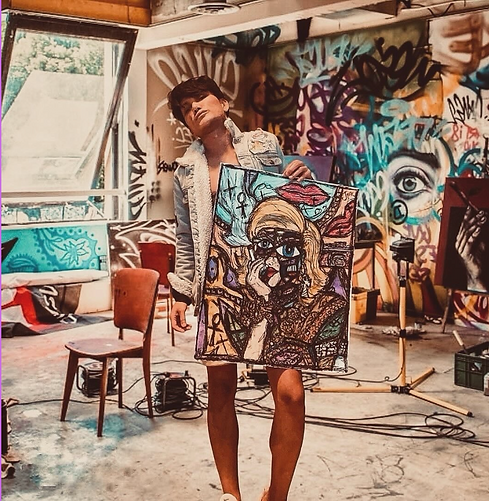
MR ANJO’s SYMBOLIC GENRE

There are artists who reflect their time. And there are artists who prefigure it.
Mr. Anjo belongs to the latter.
Emerging not from institutional studio systems or art academies, but from a lived, global experience of rupture, reinvention, and resilience, Mr. Anjo’s visual language is one of constructed memory, emotional sovereignty, and radical historicity. His practice is not simply about what he paints, but why he paints — and what is at stake in that act.
Born in Melbourne, with artistic roots extending across continents and cultures, Mr. Anjo is a cultural polyglot who has intuitively developed a visual grammar that transcends genre. His work seamlessly merges symbolist depth, postmodern rupture, and archaic permanence, without aesthetic compromise or nostalgia. This fusion is not accidental — it is intentional, and it marks the artist’s commitment to redefining legacy in real time.
What makes Mr. Anjo urgent in the 21st-century canon is not only his distinctive aesthetic signature — a vivid palette of 24 oil pastels, bold contour lines, metallic accents, and his iconic Ankh symbol — but the way he repositions memory as a raw material. His canvases do not merely depict; they embody. His paintings are acts of memorialization, sites of tension between fragility and permanence, brightness and grief, empire and identity.
While frequently compared to Basquiat in spirit, Klimt in luminosity, and Warhol in cultural semiotics, Mr. Anjo diverges from these precedents in one important way: he is not building upon modernism — he is post-temporal. His work is not retrospective; it is prophetic.
A Practice Rooted in Emotional Archeology
Central to his body of work is the idea that history is not static — it is porous. By weaving ancient symbolism with contemporary emotional states, Mr. Anjo creates what might be called emotional archaeology: layered compositions in which color becomes biography, line becomes rupture, and form becomes myth.
The Ankh, which appears across his work, functions not only as a motif of life but as a curatorial device. It marks each piece as part of a larger cosmology — a visual archive where each work acts as a constellation within a personal yet universal mythology.
This archival quality positions Mr. Anjo’s work within an important curatorial conversation: how do we catalog survival? How do we institutionalize grief, joy, and memory in ways that resist erasure? Mr. Anjo answers not with commentary, but with testament. His works are documents. Emotional palimpsests. Cultural heirlooms for a future yet to come.
Beyond Technique: Toward Truth
It would be a mistake to view Mr. Anjo’s disregard for academic precision as naive. On the contrary, it is deliberate rejection — a refusal to conform to frameworks that have historically excluded or diminished emotional honesty. In this way, his work aligns with the philosophies of Gutai, AfriCOBRA, and early postcolonial abstractionists: artists for whom technique is subordinate to meaning.
His technical “imperfections” are a statement in themselves — a resistance to perfectionism as colonial residue. His is a practice in which truth is more valuable than symmetry, and line becomes a wound rather than a boundary.
This is precisely why Mr. Anjo belongs on the walls of leading institutions and collections: his work does not participate in contemporary art — it contests it, and in doing so, it redefines its terms.
Mr. Anjo: Neo-Cubist Symbolic Expressionism
Mr. Anjo’s artistic practice stands at a unique intersection of Neo-Cubist architecture, symbolic expressionism, and sacred iconographic revival. His work is defined by fractured geometries, emotionally charged color fields, and recurring metaphysical symbols—most notably the Ankh, a powerful cipher for legacy, transcendence, and inner continuity.
Rooted in philosophy and visual intensity, his style blends multiple traditions into a distinct, unified language:
• Neo-Cubism
Mr. Anjo reimagines Cubist principles as tools for emotional deconstruction—splintering forms to reconstruct psychological and symbolic truths.
• Semi-Abstract Figuration
Figures, icons, and relics emerge from layered marks—recognizable yet unresolved, inviting the viewer into states of tension and contemplation.
• Symbolic Expressionism
Each work becomes an archetypal narrative, where symbols are not ornamental but vessels of personal, cultural, and spiritual meaning.
• Postmodern Syncretism
Drawing from Ancient Egyptian, Art Nouveau, and sacred geometries, Mr. Anjo builds a timeless aesthetic that transcends reference and resists pastiche.
• Psychological Colorism
His palette is emotionally diagnostic, not representational—colors reflect states of mind, not external light.
• Hardline Contour Draftsmanship
Thick black contours, reminiscent of stained glass or cloisonné, frame each composition with intensity and clarity—form anchored in tension.
